(10) Seattle crime scene and the evidence part 2
- Burn The Rain

- Nov 29, 2019
- 13 min read
Updated: Mar 8, 2024
Kurt's bloodstream heroin level
After the autopsy, the toxicology report was written. It was never released to the public.
"The Seattle police cannot release the information to the media because reports and records of autopsies are confidential and protected under state and federal law". (According to Seattle Police. Autopsies are under the public domain)
On April 15, 1994, the Seattle Post-Intelligencer reported that Kurt Cobain was "high on heroin when he pulled the trigger". The paper reported that the toxicological tests determined that the level of morphine in Cobain's bloodstream was 1.52 milligrams per liter.
There was also evidence of diazapam found in his blood, the source said.
The heroin dose found in Mr. Cobain was "a high concentration, by any account,"
said Dr. Randall Baselt, who is head of the Chemical Toxicological Institute in Foster City, Calif.
A fragment from documentary: Autopsy, The last hours of Kurt Cobain. Kurt's toxicology results are shown in this clip. Next to a staggering amount of heroin, there where also traces of Diazepam like substance found in Kurt's blood.
Diazepam is generally synonymous with the more well-known drug Valium, and sometimes the term diazepam refers to the generic category of drugs known as benzodiazepines. This class of drugs is regarded as sedative-hypnotic and is not cross-tolerant to opioids. That means addicts can use diazepam and similar drugs in the same way that non-addicts use them. Conversely, even a heroin addict will experience toxicity to benzodiazepines in the same manner as a non-addict. A junkie is not immune to the toxic effects of a benzodiazepine overdose simply because he or she can handle a big dose of heroin.
Reports show that “as both drugs cause respiratory depression...death resulting as a consequence...is greater than if either drug were taken alone.”
The effect of relaxation is as increasing heroin absorption in the brain, a factor which addicts often attempt to manipulate, e.g. by using heroin with a relaxant such as a benzodiazepine.

Kurt's Toxicolgy report
There was 1.52 mgs per liter of morphine/heroïn in his blood
Article of the Seattle Post Intelligencer, April 15, 1994 describes that Cobain was high on heroin and diazapam when the trigger was pulled. The article says: ' Rock singer Kurt Cobain was high on heroin and Valium when he 'killed himself' April 5, three days before his body was discovered at his posh Seattle home.
The 1.52 mg actually refers to the level of drugs found in Cobain’s blood, not the amount
he originally injected. Cobain would have needed to inject much more than 1.52 mg of heroin to help even the mildest headache. In fact Cobain would have had to inject as much as 225 to 240 mgs of heroin to reach a blood morphine level of 1.52 mg. No doubt exists that a blood level of 1.52 mg of morphine per liter is over three times the lethal dose.
What Is A Lethal Dose Of Heroin?
The lethal dose range of intravenous heroin is generally regarded as 10 mg to 12 mg. Sometimes even a tiny dose can kill, so the lethal dose of intravenous heroin can go as low as 3 mg, possibly even lower. Some people get confused and think that high variability in the minimum lethal dose means that a similar variability exists for the maximum lethal dose. The most serious heroin addicts will die with virtual certainty with much less than a dose of 75 mg to 80 mg of heroin.
After many studies it is clearly established that 75 mg to 80 mg is the maximum lethal dose for even the most severe heroin addicts. Note that in a low tolerance person, in an average hospital setting, a small effective therapeutic dose of intravenous heroin is only 3 mg to 4 mg.
The important thing to note here is that the problems associated with establishing a “lethal dose” for intravenous heroin primarily relates to the problem of establishing a “minimal lethal dose,” i.e. the smallest amount of heroin which will kill.
The “maximum lethal dose,” i.e. the highest dose of intravenous heroin a severe heroin addict can withstand without immediately collapsing into a coma and/or immediately dying, is very well documented.
The blood morphine level of 1.52 mg per liter found in Cobain’s body represents a heroin dose which is substantially higher than this well established maximum lethal dose.
The Lange manual for Poisoning & Drug Overdose states that for opiates, “with higher doses, coma is accompanied by respiratory depression and apnea often results in sudden death.” Basically, a high lethal dose of heroin will either cause immediate death or, in an unlikely scenario, immediate incapacitation by rendering the recipient comatose. This is described by Staub, et al. as follows: “...we have shown that in 85% of the cases, the death should be attributed to a so-called ‘golden shot’. In the remaining cases, the death is not so rapid and a survival period in a comatose state has to be taken into consideration.”
Compensating For Body Weight
A blood morphine level of 1.52 mg/L indicates a heroin intake of approximately 225 mg - 240 mg. D espite suggestions that Kurt may have simply been incapacitated by a normal, large dose fit for an addict, it must be noted that his body weight was at highest 130 lbs, and he was listed as being 115 lbs. in late 1993. This would generally increase his susceptibility to overdose by as much as 20%, since toxicity data is based on a 150 lb. adult.
From Love & Death, The Murder of Kurt Cobain by Max Wallace and Ian Halperin:
Like hundreds of thousands of teenagers around the world, Rochelle Marshall was devastated when she heard the news about Kurt Cobain’s death. Like many of them, she and her friends started asking questions after the murder theories began to circulate. Unlike most of them, however, her mother was in a position to provide answers. “My daughter was very disturbed at first. She wasn’t sure he had really killed himself, and I told her, ‘Well, a lot of people feel that way about a suicide because they just can’t believe it, or they don’t want to believe it.’ But she said this was different. She wanted me to look into it.”
Marshall was well suited for the task. As a deputy coroner in Colorado, she has investigated hundreds of deaths, including countless suicides and murders. During her years as a forensic medicolegal investigator, she says, she has learned one important lesson: “Things aren’t always as they appear at first.”
It’s the heroin levels that she claims are the clincher. “When I saw the blood morphine results of the toxicology tests—1.52 milligrams per liter—I immediately said to myself, ‘How could he have pulled the trigger?’ That just didn’t make sense. With that much heroin in his system, it would have been virtually impossible.” "When heroin enters the bloodstream, she explains, it is were none even approaching those kinds of levels,” she said. “As a matter of fact, when I started searching further through the state, I just couldn’t find any cases with those levels. The amount of blood morphine in Cobain’s blood was truly amazing. With levels that high, he just wouldn’t have been conscious long enough to pull the trigger.” How could Kurt have shot himself after injecting that much heroin?
Marshall is particularly disturbed about what she believes was a rush to judgment by both the police and the deputy medical examiner, who they were still at the scene. “That in itself is ridiculous,” says Marshall. “I don’t know of any case that’s an open-and-shut case of suicide, and that’s what they all did in this case: they immediately ruled it a suicide. You just don’t do that. You wait for all the test results to come back and you investigate the circumstances before you rule. That’s just how it’s done.” Even in this situation, with a suicide note at the scene and the shotgun still in the victim’s hand? “That’s one of the things I’m concerned about,” she responds. “In the majority of suicides, there is no note. I’m always a bit suspicious when there is one, at least suspicious enough to take a closer look."
Detective Ciesynski: "The amount of heroin that he injected was ten times more then anybody would have taken. Even for a heavy heroin user. He gave himself a fatal dose with black tar heroin".
Detective Ciesynski: "The amount of heroin that he injected was ten times more then anybody would have taken. Even for a heavy heroin user. He gave himself a fatal dose with black tar heroin".
Detective Ciesynski: "I have never seen anybody with an overdose in our County at least, that had that much heroin in his system".
Even the Seattle police department confirms that Kurt had so much heroïn in his stystem, that that alone could have killed him. If Cobain had such a staggering amount of heroïn in his blood, he would have been unconscious in seconds. How was Kurt then able to pull the trigger if he had a fatal overdose?
Nikolas Hartshorne, the medical examiner, explained that the tolerance levels were the factor, he explained. A severe addict like Cobain has a much higher tolerance than the average user; the opiates would therefore have taken longer to render him unconscious.
“He was a serious junkie,” said Hartshorne. “His system could process higher amounts of heroin than [that of] the average person.” Hartshorne’s supervisor, Dr. Donald Reay, who was King County’s chief medical examiner at the time, concurred. “It is really an issue of tolerance: how much is this person used to,” said Reay. “If a person has gradually over months or years increased the dose, a person could function with that amount of drugs.”
Denise Marshall is unconvinced. “Certainly, tolerance does play a factor, there’s no doubt about it. I won’t argue with that,” she says. “But I’ve never seen anybody with his levels.
It’s just staggering. If tolerance was that important, you wouldn’t have so many heroin addicts overdosing all the time, and with levels significantly lower than what Cobain had in his blood.”
Toxicology
None of 3,586 Suicides Show Parallel To Cobain Case
A study of all 96 gunshot suicides in Victoria, Australia during 1988, demonstrates that none of the 64 cases where the blood was analyzed involved narcotics. Only two cases had taken an overdose of any kind: one drinking Paraquat, and the other taking oxazepam, alcohol, and imipramine. Selway and Nower‘s studies collectively deal with 147 suicides in which a gunshot was the cause of death, yet not one single case even distantly resembled the supposed scenario for Cobain’s “suicide.” The 1,862 suicides studied by Gatter included 369 violent deaths, with 51 gunshot suicides as well as a significant degree of drug overdoses. Yet again, no parallel exists to Cobain’s case. Cooper & Milroy’s study involved 536 suicides, 246 of which were violent, 10 of which involved a gun.
Thus, in 3,586 total suicides, including 208 suicides by gunshot, no case remotely resembles a situation where a gunshot of any kind and a heroin overdose of even minor proportions occurred.
Some Notes & Questions:
It's very odd that Courtney Love, some friends, some family members and media only started to spread the suicide story after Kurt Cobain was died. When Kurt was alive no one ever mentioned him being suicidal. He never talked about it and didn't seem depressed. That doesn't mean that he couldn't have killed himself. A person in general can be happy with others and can be depressed the next moment. But it doesn't add upp with what people say about his nature who used to know Kurt. They all said that he seemed very happy. No one ever said that Kurt was depressed, there where no other family members that commited suicide, Kurt never talked about it and he was never diagnosed and treated for having depressions. He loved making music and he adored his daughter and would never leave her. Sometimes Kurt could be quiet for some time and his mind was filled with dark sarcastic humor. His humor was taken way to seriously and misunderstood by most people. His lyrics where a pile of contradictions. He would write what was going on in his speed racer mind. That doesn't mean that all the lyrics are about Kurt. Most lyrics where written in a surrealistic, dark and creative way.
Kurt was obsessed with babies, sickness and death so he used those themes in his life and art. (The baby on the Nevermind album cover?) He wrote stories and wanted to name in Utero: I Hate Myself and I Want To Die. But he said that people would misunderstood the concept so they changed the name in in Utero. All this was pure creative. Kurt was obsessed with darkness, babies, sickness, vomit, all those things people normally never even would think or talk about. These themes where visible everywhere. In his journals, his art, his music. If you pick all those dark things out, put them under a different day light and put it all together, you could create a reality where it seems that Kurt was depressed and took his own life. But it doesn't add up with what people say who used to know Kurt and it doesn't add upp with how Kurt was found. (The evidence points to murder)
The medical examiner estimated that Kurt Cobain died around April 5, 1994. This seems very unlikely. It seems that Courtney pushed Kurt into a dark corner. She forced him into intervertion. She forced him to go into rehab (while Courtney, friends and band members were drunk and on drugs themselfs all the time) and she knew where Kurt was when she filled the missing person's report (claiming that Kurt's mother filled the report)
Courtney Love knew that Kurt Cobain came home in Seattle on April 2, 1994. He was seen by Micheal Cali dewitt and his girlfriend Jessica Hopper. Kurt came in their room, was seemingly happy, making jokes.
*If Micheal Cali dewitt saw Kurt Cobain, and if he knew that Kurt was suicidal, why did Cali leave a note (where guilt is being used upon Kurt. Like: I cannot believe that you are not here, get everything together, think about your wife, do something now! Kinda threatening note Cali used for someone who is supposed to be suicidal?) on the stairs in the Seattle house if he was hardly there, as he claimed to private investigator Tom Grant?
*Why use guilt/pressure and threatening for a person that was supposed to be 'suicidal' as Courtney Love claims?
Kurt Cobain had his hospital/rehab bracelet on his left arm when he was found. Together with his belongings: his coat, hat, sunglasses, money, cigarettes etc.
As if the impression was made that Kurt took his own life soon (He didn't do it himself, but the suicide story is now accepted by the Seattle police as the official story) after he came home. But the medical examiner said that Kurt died around April 5, 1994.
It is very likely that the medical examiner who was close friends with Love changed this date in favour of Courtney to make it appear that Kurt was missing for a time. It would then synchronize and fit with Courtney's story that Kurt was suicidal, bought a gun and was missing.
All that time that Kurt was not seen, Courtney knew where Kurt was. She heard this from Cali and other friends. Love knew that Cobain had died before it came out. She knew that Kurt was laying in the Greenhouse for 6 days before he was found.
That means that Kurt didn't die on April 5, 1994, but days earlier. Kurt was seen April 2, 1994. Courtney Love calls Tom Grant on April 3, 1994 and hires him to find to Kurt.
Courtney Love never mentioned to Tom Grant that Kurt Cobain was seen at their Seattle home April 2, 1994.
*Why didn't Courtney mention to Grant that Kurt called Courtney and left her a number on April 1, 1994? As proven in the hotel phone records.
*Why didn't Courtney mention that Kurt was seen the day before she called Grant?
Kurt Cobain died not long after he came home on April 2, 1994.
Can you kill yourself with a gun? Yes, that is possible.
Can you kill yourself with an overdose of heroin? Yes, that is possible.
It never happed both at the same time though. Never was there a case in history where a person shoots himself with such enormous amounts of heroin (three times the lethal dose for a severe user) puts everything neatly away in a box near him, roll down his sleave and shoots himself with a shotgun.
*Why would Kurt do so much effort to put his syringes neatly away in his drug paraphernalia cigarbox near him if he was suicidal?
*Why would Kurt take all his belongings with him to the Greenhouse if he was going to take his own life?
*Why didn't Kurt leave his coat, sunglasses, money, and other belonings in his home and then go to the Greenhouse?
Where did Kurt write his fans farewell note? Did Kurt went to the Greenhouse with his hat and coat on and wrote the note there to then kill himself? Or did he write the note on another place?
*Why are there different notes found written by Courtney love? The note to his fans (where the last four lines are written by Courtney) and the note found in Kurt's pocket when he was found? Courtney later admitted that it was a joke and that she wrote the note.
Then there was another note found on a stool that stood in the room of the Greenhouse where Cobain was found: Now You Have Many Legs To Stand On. The note was attached to a stool with many legs. The stool had so many legs that you had no idea how many legs were attached.
*Why was that note placed on that stool at that time? For what reason? And why particularly in the Greenhouse?
*Kurt Cobain was very high on heroin when he died. Why would he not enjoy this staggering dosis of heroin and shoot himself with a gun before the heroin had any change to take effect?
*Wouldn't it be easier to die from an overdose of heroin alone? Why use a shotgun if heroin alone could make you sleep and never wake up?
*Why would you leave your wife, your daughter, family and friends behind with such a violent death? And with so many questions?
*Why does Courtney Love do nothing to stop the murder allegations?
Why do Courtney Love, Cali and Jessica Hopper don't answer some important questions about Kurt's mood and whereabouts in the last days of his life?
*Why were there no fingerprints found on the gun that was found on the crime scene?
Did Kurt shoot himself and then whipe the gun clean afterwards?....
Something doesn't seem right...
It looks like someone placed Kurt Cobain in the Greenhouse, and placed his coat, hat, sunglasses, money etc near him. Someone gave Kurt large doses of black tar heroin and valium in stages, brought him to the Greenhouse (which was accessible though a small stairwell. The stool stood at the other side of the room. The stool was standing before some French doors. Behind those doors was a balcony. Why would Kurt lock himself in a room and place a stool before the door, if the stool was at the other side of the room? That means that the stool was standing before the French doors with a balcony. There was nothing standing against the other door and had a simple lock. Free and easy access for everyone really)
and placed the shotgun in Kurt's hands and fired it. The note was later added to make it appear a suicide. The Greenhouse had a lock from the outside. Everyone came in and out the house all time. Everyone could have entered the Greenhouse.
Read for more information our third part: The Seattle crime scene and evidence part 3

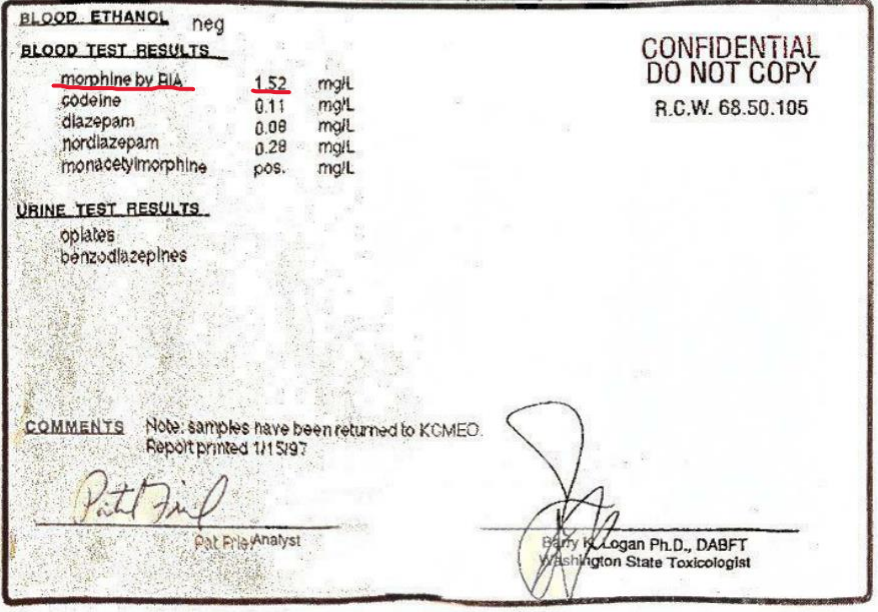





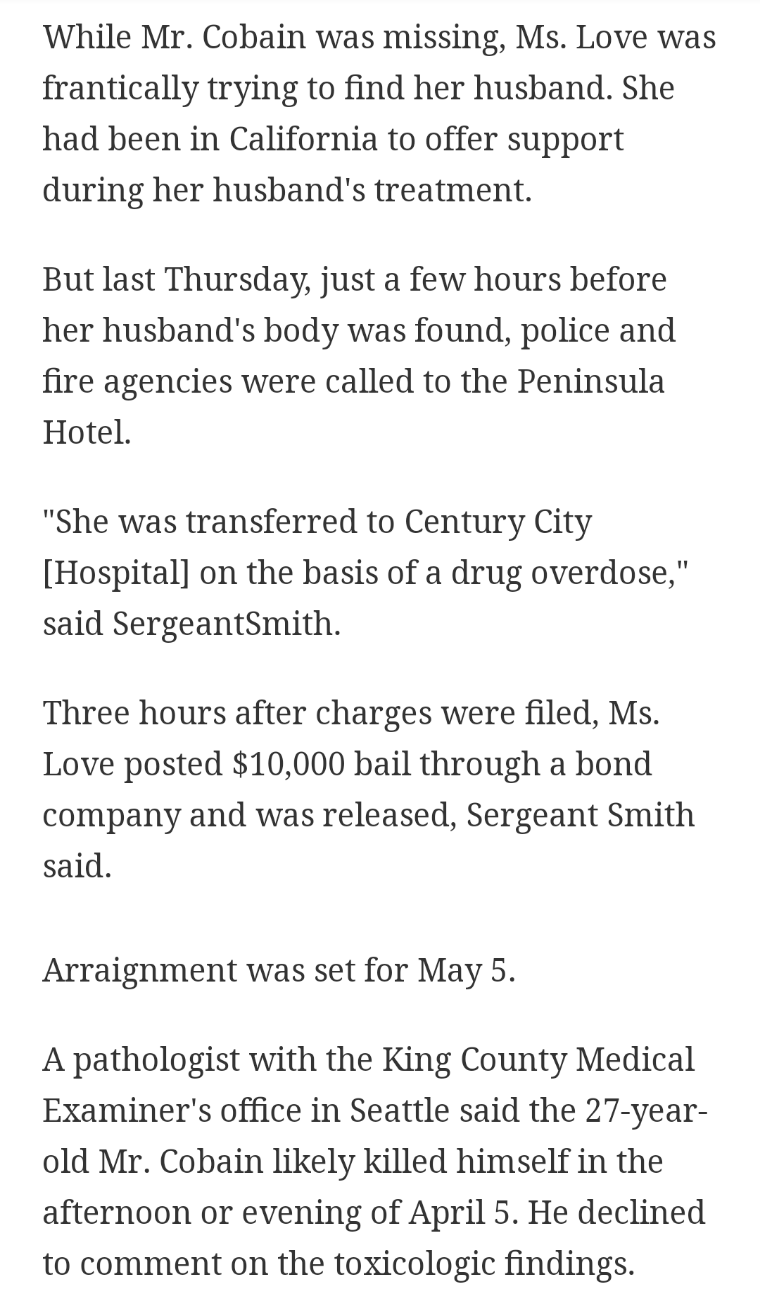

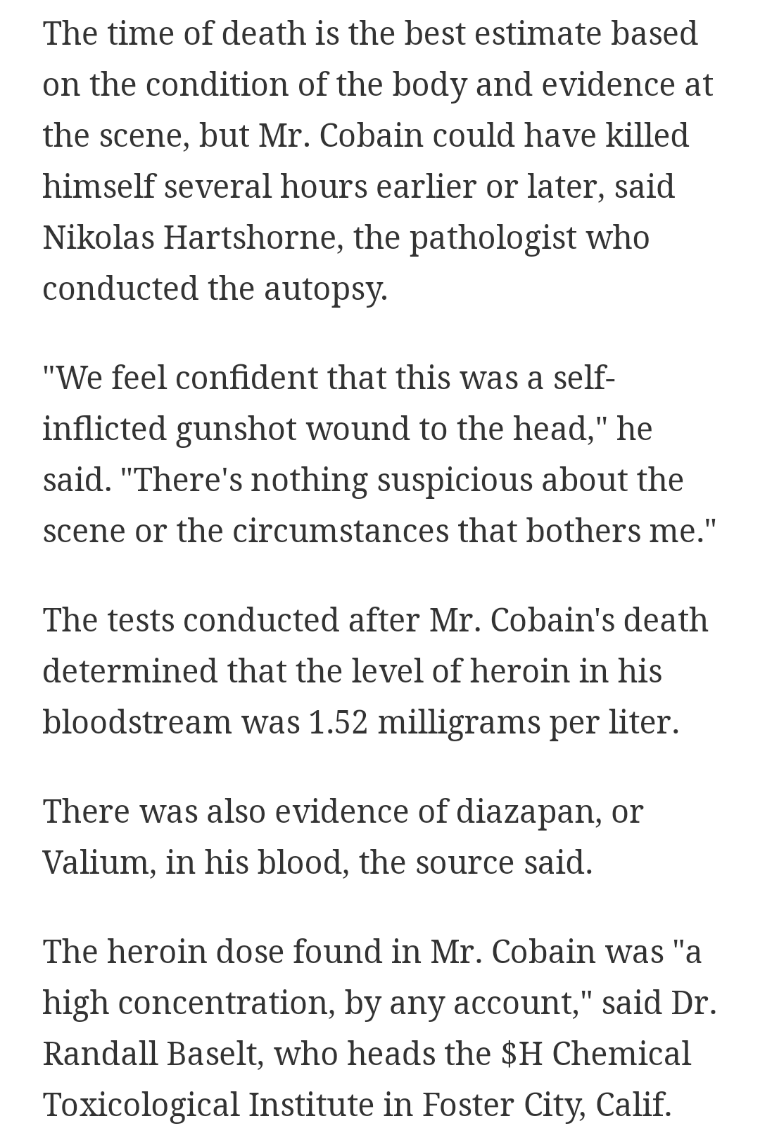

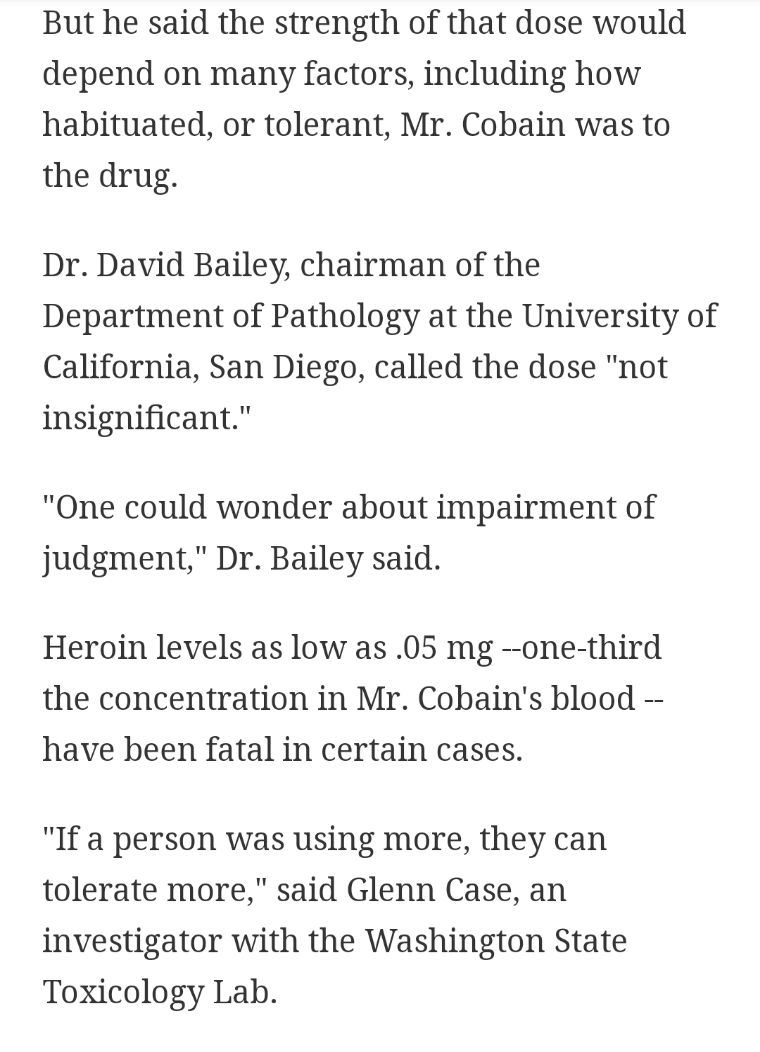

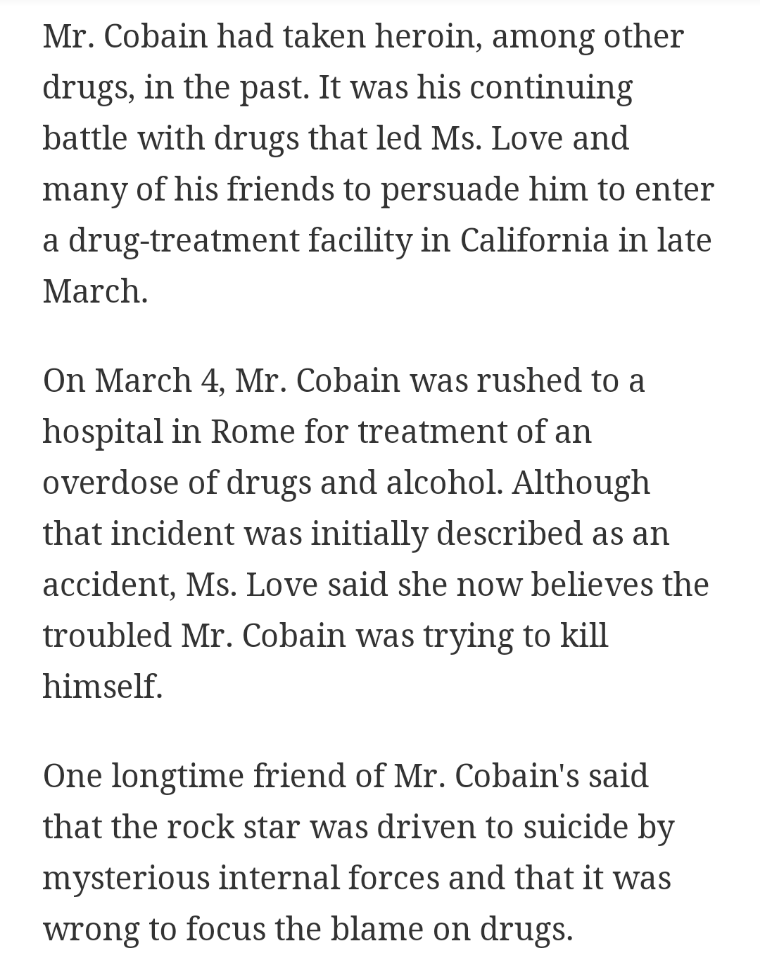

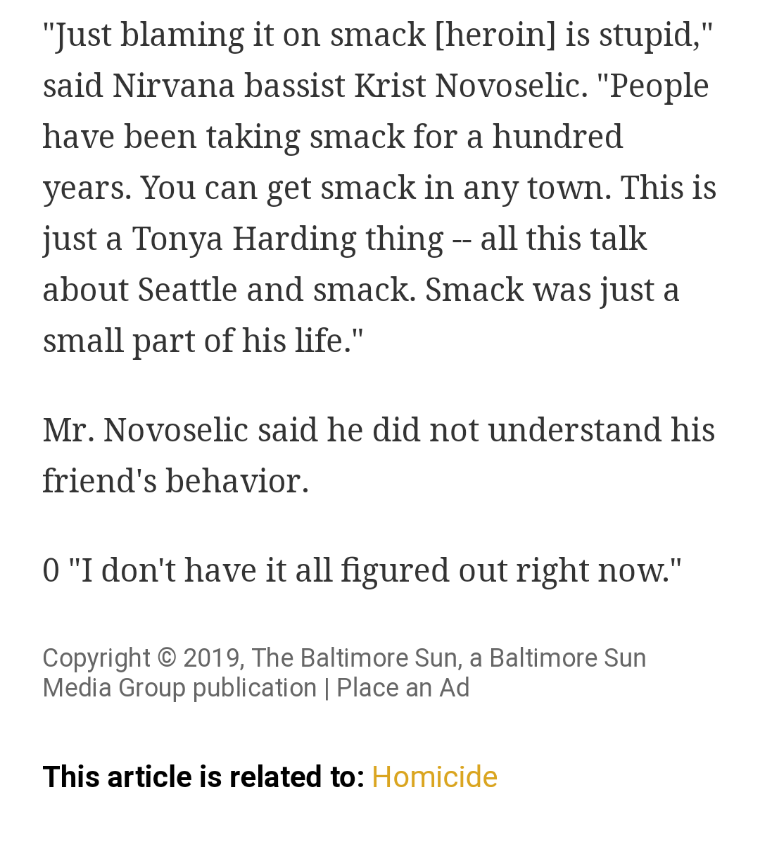



Comments